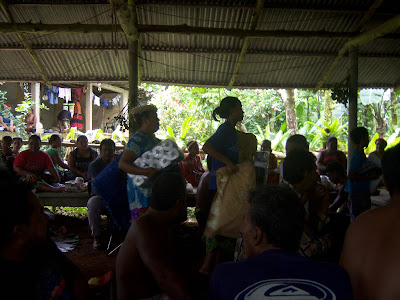When I see little black bugs crawling all over the water seal toilet, I freak out.
I often amuse my host family by freaking out over the
various insects that like to invade my space (or my chocolate). You would think that after being here for
over a year I would be used to them by now.
Not quite. But I am well equipped
with a can of Raid to go after the little buggers.
 |
| Behold the toilet |
When I see my fellow PCVs all together in the same place, I
freak out.
M77’s Mid Service Training was held at the eco-friendly
Village Hotel. I slept on a water bed
under a mosquito net, housed in a thatched-roof bungalow. Volunteers from all over the Caroline Islands came back to rainy Pohnpei to reflect on
the first year of service and prepare for the next. Our training encompassed a variety of
subjects, including sexual assault and intervention, communication, and
content-based teaching. More important
than the training though, was the time in which we all bonded over our crazy experiences
navigating through Micronesian and Palauan culture. I am honored to serve with this incredible
group of people.
 |
| Coming in after the midnight flight |
When I watch my students flawlessly perform their skits, I
freak out.
This quarter has kept me and my students very busy. My freshmen practiced subject-verb agreement,
learned vocabulary words, read Micronesian legends, wrote about personal
memories in their journals, and created and executed skits based on both topics
I gave them and topics of their own choosing.
I was stunned at how well my students did in acting out their completely
English, completely memorized skits. My
goal was to give these students confidence in their ability to communicate in
English, and I think together we accomplished this.
My juniors embarked on reading adventures with Island of the Blue Dolphins, Call It Courage, and The Pearl. Thanks so much again to my family and friends
who sent me copies – they were much appreciated and fully used. They also learned vocabulary words, wrote
essays about different prompts, journaled about future dreams, and faced off in
engaging debates.
 |
| Some of my freshmen girls |
Not in a bad way, mind you.
My time in Pohnpei, especially at my site, has been absolutely wonderful
(if you can’t tell from my previous entries, hehe). I can only hope that I’ve given a little
something in return for all that’s been given to me. However, I know that without the support of
everyone back home I would not have been successful here. I can’t wait to see you all (especially my
newest family member) but don’t freak out if I start acting a bit strange!
 |
| Season’s Greetings from Pohnpei |


























